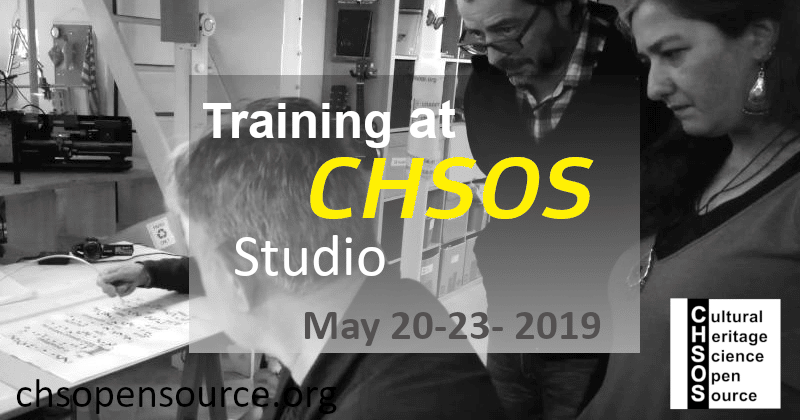
Just completed the 4-days Training at the CHSOS Studio, May 20th-23rd. We got 4 participants from the Netherlands and Greece.
Check out our Calendar for the next one.
For this training program, we wanted to focus on different kinds of transmitted radiation methods which are not standard but we wanted to experiment a little bit to see what worked better for imaging watermarks and highlight paper manufacturing. So we did try UV, VIS, and IR all in transmission and it was so interesting.
This Training program was focused on works on papers. We chose a beautiful 17th-century copper engraving with a view of the coast of the island of Seram, in the Moluccas, just above Ambon. The right is VOC fort Goelegoele, nowadays Gulegule, just outside the city of Urung, on the eastern tip of the island. In the docks is a VOC ship that is being surrounded by local boats. Published in 1676 in Amsterdam in ´ W. Schoutens gedenk-waardige reysen naar Oost-Indien´. Engraved by Coenraet Decker. We practice TP on this print but also it was the occasion to test imaging with transmitted radiation, from UV to the IR in order to make the features of the paper as well the watermarks more readable.
Participants
Gabrielle Beentjes and Gerrit de Bruin. National Archives Netherlands. Gabrielle and Gerrit are senior Conservation specialists interested in matters concerning preventive conservation: climate, exhibition conditions, packaging, etc and they are following the conservation science research on these topics at the National Archives.
Argyrios Koniditsiotis and Eftychia Papadopoulou. Based in Athens, they are both Conservator of antiquities and works of art. They have been working for the Greek Ministry of Culture and the last two decades as contractors at “cm2 project “. They are working for the Greek Ministry of Culture and recently as freelancers, specialized in wall paintings, wooden polychromies, and icons. The last ten years they have been trying to enrich their work using imaging and non-destructive analytical techniques and they have been following CHSOS 🙂
Technical Photography in Transmission mode
FIRST DAY: Reflectance Spectroscopy and Raman Spectroscopy
We started with Reflectance spectroscopy with Gorgias and Raman Spectroscopy using Elvira
Reflectance spectroscopy (RS) is a powerful portable technique for the identification of pigments.
An RS spectrum shows the ratio between the intensity of the reflected light and the incident light for each wavelength. The RS spectra can provide information useful for pigments identification.
SECOND and THIRD DAY: Technical Photography
Technical photography represents a collection of images realized with a modified digital camera sensitive to the spectral range (about 360-1100 nm). Different lighting sources and filters are used to acquire a selection of technical images, with each one providing different information about the object under examination.
FOURTH DAY: Multispectral Imaging
Multispectral Imaging is used to identify and map pigments in polychrome artworks, and to enhance the reading of faded historical documents. Conservators can use this technique to distinguish original
sections in paintings and select the proper conservation procedures.
Next Training at CHSOS Studio Italy – December 2019
For the next Training program in December, we will practice with two Chinese paintings on silk laid down on medium cardboard depicting males in different attires and a beauty with children, early 20th century. The objects are in good overall condition, showing some rubbing and repairs. These items come from a private collector in London who over a period of 20 years acquired his collection from various prestigious dealers and has decided now to downsize it.

[post-content post_name=training-for-institutions/]
[post-content post_name=1-ads/]





















